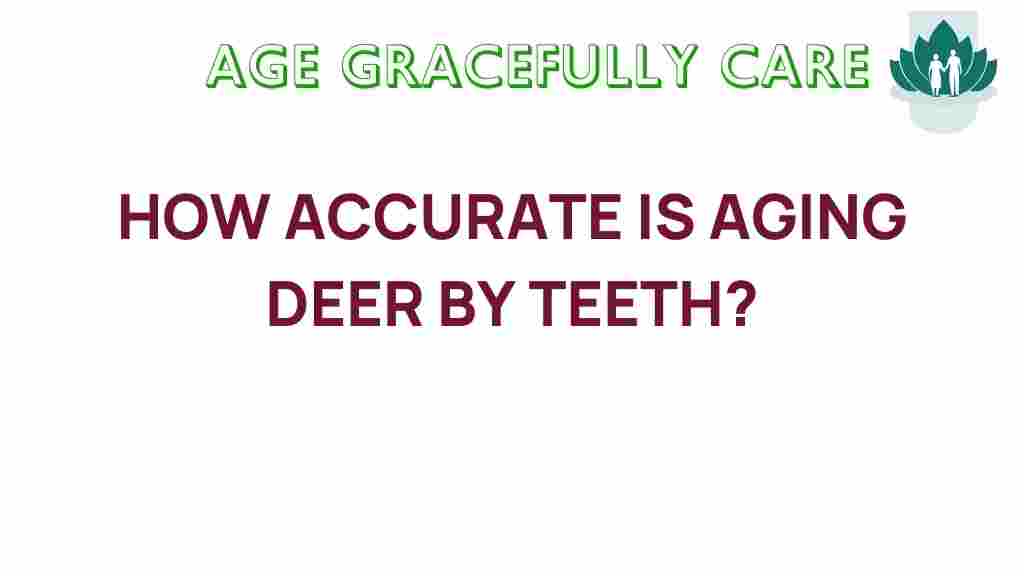Aging Deer: Unveiling the Secrets Behind Dental Aging
Understanding how to age deer is a critical aspect of wildlife management. It not only assists in monitoring deer population dynamics but also provides insights into hunting techniques and animal behavior. One of the most commonly used methods for aging deer is through their teeth. In this article, we will explore the accuracy of aging deer by teeth, the science behind dental aging, and its implications for ecological studies and wildlife research.
Introduction to Dental Aging in Deer
The aging of deer is essential for effective wildlife management. Knowing the age of a deer can influence decisions regarding population control, hunting regulations, and habitat management. The method of dental aging relies on observing the wear and development of teeth, which can indicate the age of the animal. This technique has been widely accepted but raises questions about its accuracy and reliability.
The Importance of Aging Deer
Aging deer is crucial for several reasons:
- Wildlife Management: Understanding the age structure of deer populations helps in making informed management decisions.
- Deer Population Studies: Aging data contributes to population modeling and ecological studies.
- Hunting Techniques: Knowledge of age can enhance hunting strategies and improve ethical hunting practices.
- Animal Behavior: Age influences behavior, reproductive success, and survival rates in deer.
How Aging Deer by Teeth Works
The process of aging deer through dental examination involves several steps:
1. Examining Incisor Teeth
Deer have two sets of incisor teeth in their lower jaw. The first set is present at birth, and a second set emerges as the deer matures. The pattern of eruption and wear can indicate age:
- At 1.5 years, deer will have their first set of incisors fully developed.
- By 2.5 years, the second set of incisors begins to appear.
- At 3.5 years and older, wear patterns become more pronounced.
2. Assessing Premolar and Molar Teeth
In addition to incisors, the premolars and molars also provide age-related information:
- Premolars show wear patterns that correlate with age.
- Molar teeth can exhibit changes in morphology, such as the flattening of cusps.
3. Identifying Tooth Wear
Tooth wear is one of the most significant indicators of age. Factors influencing wear include:
- Diet: Harder foods can lead to more significant wear.
- Habitat: Environment can affect the availability of food and the resulting dental health.
- Genetics: Some deer may naturally experience more wear than others due to genetic factors.
Accuracy of Dental Aging in Deer
While dental aging is a useful tool, it is essential to recognize its limitations:
- Variability: Individual differences among deer can lead to variations in tooth wear, making it challenging to assign a specific age accurately.
- Environmental Factors: Changes in diet and habitat can significantly influence tooth wear rates.
- Observer Experience: Accurate aging requires trained personnel familiar with dental aging techniques.
Ecological Studies and Wildlife Research
Dental aging contributes significantly to ecological studies and wildlife research. Researchers use data from tooth wear to assess:
- Population Dynamics: Understanding age structures aids in predicting population trends.
- Health Assessments: Tooth wear can indicate the overall health and nutritional status of deer populations.
- Migration Patterns: Aging data can help analyze movement and migration behaviors of deer.
Hunting Techniques and Ethical Considerations
For hunters, understanding how to age deer can improve hunting success and promote ethical practices:
- Targeting Mature Bucks: Hunters can utilize dental aging to target older, more mature bucks, which is often more rewarding.
- Conservation Efforts: Responsible hunting based on age can aid in maintaining healthy deer populations.
Troubleshooting Common Issues in Dental Aging
Here are some common challenges faced when aging deer by teeth and tips for overcoming them:
1. Inconsistent Tooth Wear
If you notice significant inconsistencies in tooth wear among deer from the same area, consider the following:
- Assess the forage availability and quality in the habitat.
- Take note of the genetic diversity within the population that may affect wear rates.
2. Difficulty in Identifying Age
When struggling to assign a specific age, remember:
- Consult experienced wildlife biologists or local wildlife agencies for additional insights.
- Utilize resources from wildlife research publications to better understand the aging process.
3. Changes in Eruption Patterns
Occasionally, deer may exhibit atypical tooth eruption patterns. To address this:
- Document any anomalies for future reference and comparisons.
- Consider cross-referencing with historical data from the area.
Conclusion: The Future of Aging Deer
In conclusion, aging deer by teeth remains a valuable method for wildlife management, ecological studies, and hunting practices. While it provides a reasonable estimate of age, it is crucial to recognize its limitations and consider additional factors that may influence tooth wear. Ongoing wildlife research and advancements in techniques will continue to enhance our understanding of deer populations and their management.
For more information on wildlife management techniques, visit this resource. For additional insights into wildlife research, check out this study.
By understanding the intricacies of dental aging in deer, we can contribute to sustainable wildlife management practices that benefit both the deer population and the ecosystems they inhabit.
This article is in the category Resources and created by AgeGracefullyCare Team
